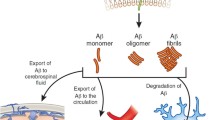Abstract
About 10 years ago, we implicated immune factors in the pathophysiology of Alzheimer disease (AD), the hypothesis being that AD may be an immunologically derived systemic disease, but clinical effects confined primarily to the brain. We originally hypothesized that an immune basis of the disease may involve faulty immune regulation and autoimmunity. As described here, the activation of immunoregulatory T-lymphocytes with CD8 phenotype may be important in the immunopathogenesis of the disease.
Similar content being viewed by others
References
Allore R., O'Hanlon D., Price R., Neilson K., Willard H. F., Cox D. R., Marks A., and Dunn R. J. (1988) Gene encoding the β subunit of S100 protein is on chromosome 21: implications for Down Syndrome.Science 239, 1311–1313.
Arispe N., Rojas E., and Pollard H. B. (1993) Alzheimer's disease amyloid β protein forms calcium channels in bilayer membranes: blockade by tromethamine and aluminum.Proc. Natl. Acad. Sci. USA 90, 567–571.
Cserr H. F. and Knopf P. M. (1992) Cervical lymphatics, the blood brain barrier and the immunoreactivity of the brain: a new view.Immunol. Today 13, 507–512.
Eikelenboom P., Hack C. E., Rozemuller J. M. and Stam F. C. (1989) Complement activation in amyloid plaques in Alzheimer's dementia.Virchows Arch. 56, 259–262.
Ferrari C., Sansoni P., Rowden G., Manara C., Torresani C., and DePanfilis G. (1988) One half of the CD11b+ human peripheral blood T lymphocytes expresses the S-100 protein.Clin. Exp. Immunol. 72, 357–361.
Gaskin F. and Fu S. M. (1992) Antineurofibrillary tangle, antineuronal and antibeta-amyloid-protein in Alzheimer's disease and related disorders.Res. Immunol. 143, 668–670.
Griffin W. S. T., Stanley L. C., Ling C., White L. McLeod V., Perrot L. J., White C. L. III, and Araoz C. (1989) Brain interleukin-1 and S100 immunoreactivity are elevated in Down syndrome and Alzheimer disease.Proc. Natl. Acad. Sci. USA 86, 7611–7615.
Huges R. (1994) Immunotherapy for multiple sclerosis.J. Neurol. Neurosug. Psychiat. 57, 3–6.
Itagaki S., McGeer P. L., and Akiyama H. (1988) Presence of T-cytotoxic suppressor and leucocyte common-antigen-positive cells in Alzheimer's disease brain tissue.Neurosci. Lett. 91, 259–264.
Jander S., Heidenreich F., and Stoll G. (1993) Serum and CSF levels of soluble intercellular adhesion molecule-1 (ICAM-1) in inflammatory neurologic diseases.Neurology 43, 1809–1813.
Marshak D. R. (1990) S100b as a neurotrophic factor.Prog. Brain Res. 86, 169–181.
McGeer P. L. and Rogers J. (1992) Anti-inflammatory agents as a therapeutic approach to Alzheimer's disease.Neurology 42, 447–449.
McRae A., Dahlstrom A., Polinsky R., and Ling E. A. (1993) Cerebrospinal fluid microglial antibodies: potential diagnostic marker for immune mechanisms in Alzheimer's disease.Behav. Brain Res. 57, 225–234.
McRae-Degeurce A., Booj S., Haglid K., Rosengren L., Karlsson J. E., Karlsson I., Wallin A., Svennerholm L., Gottfries C. G., and Dahlstrom A. (1987) Antibodies in the cerebrospinal fluid of some Alzheimer's disease patients recognize cholinergic neurons in the rat central nervous system.Proc. Natl. Acad. Sci. USA 84, 9214–9218.
Miller A. E., Neighbour A., Katzman R., Aranson M., and Lipkowitz R. (1981) Immunological studies in senile dementia of the Alzheimer's type: evidence for enhanced suppressor cell activity.Ann. Neurol. 10, 506–510.
Muller-Hill B. and Beyreuther K. (1989) Molecular biology of Alzheimer's disease.Annu. Rev. Biochem. 38, 287–307.
Rogers J., Cooper N. R., Webster S., Shultz J., McGeer P. L., Styren S. D., Civin W. H., Brachora L., Bradt B., and Lieberburg I. (1992) Complement activation by β amyloid in Alzheimer's disease.Proc. Natl. Acad. Sci. USA 89, 10,016–10,020.
Singh V. K. (1990) Neuroimmune axis as a basis of therapy in Alzheimer's disease.Prog. Drug Res. 34, 383–393.
Singh V. K. (1994) Studies of neuroimmune markers in Alzheimer's disease.Mol. Neurobiol. 9, 73–81.
Singh V. K. (1996) Neuroautoimmunity: pathogenic implications for Alzheimer's disease.Gerontology (in press).
Singh V. K., and Fudenberg H. H. (1986) Detection of brain autoantibodies in the serum of patients with Alzheimer's disease but not Down's syndrome.Immunol. Lett. 12, 277–280.
Singh V. K., Fudenberg H. H., and Brown F. R., Jr. (1987) Immunologic dysfunction: simultaneous study of Alzheimer's disease and older Down's patients.Mech. Aging Devel. 37, 257–264.
Singh V. K., Yang Y. Y., and Singh E. A. (1992) Immunoblot detection of antibodies to myelin basic protein in Alzheimer's disease patients.Neurosci. Lett. 147, 25–28.
Singh V. K., Cheng J. F., and Leu S. C. (1994) Effect of substance P and protein kinase inhibitors on β-amyloid peptide-induced proliferation of cultured brain cells.Brain Res. 660, 353–356.
Strittmatter W. J., Saunders A. M., Schmechel D., Pericak-Vance M., Enghild J., Salvesen G. S., and Roses A. D. (1993) Apolipoprotein E: high-avidity binding to β-amyloid and increased frequency of type 4 allele in late-onset familial Alzheimer's disease.Proc. Natl. Acad. Sci. USA 90, 1977–1981.
Tomkinson B. E., Brown M. C., Ip S. H., Carrabis S., and Sullivan J. L. (1989) Soluble CD8 during T cell activation.J. Immunol. 142, 2230–2236.
Author information
Authors and Affiliations
Rights and permissions
About this article
Cite this article
Singh, V.K. Immune-activation model in Alzheimer disease. Molecular and Chemical Neuropathology 28, 105–111 (1996). https://doi.org/10.1007/BF02815211
Received:
Accepted:
Published:
Issue Date:
DOI: https://doi.org/10.1007/BF02815211




